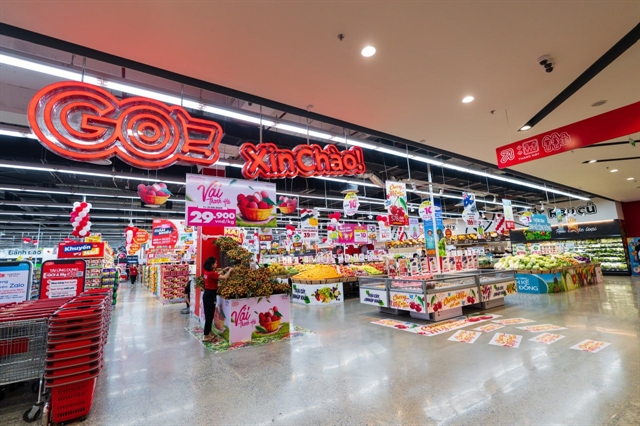 Economy
Economy

 |
| A GO! mall of Central Retail Vietnam. — Photo courtesy of the firm |
HÀ NỘI — Foreign businesses are pumping more investments into Việt Nam's lucrative retail industry, which has a market size of US$142 billion and is expected to increase to $350 billion by 2025.
Central Retail Corporation (CRC), the largest retailer in Thailand, has announced its most significant investment in Việt Nam at 50 billion baht (US$1.45 billion) in the 2023-27 period to accelerate its market presence in the country.
Yol Phokasub, Chief Executive Officer of CRC, said his firm saw Việt Nam as a highly potential key market with continuous economic growth.
CRC first entered the market as a fashion retailer with only a few branches, and since then has been expanding its business in Việt Nam for 11 years. Currently, it has more than 340 stores across 40 provinces.
Olivier Langlet, Chief Executive Officer of Central Retail Vietnam, said Việt Nam’s economy continues to grow despite uncertainties.
"We expect Việt Nam’s GDP growth this year at 6.7 per cent, making the country Southeast Asia’s fastest-growing market."
"The country’s urbanised population also continues to grow alongside modern trade and the rising number of international travellers. With these positive signals, Central Retail continues to expand its business to serve Việt Nam consumers’ lifestyle best," he said.
With CRC's strong foothold in the country, the firm has set a five-year roadmap to continue its expansion there, allocating 50 billion baht over five years. It also aims to double the number of stores to 600 across 57 of 63 provinces in Việt Nam.
The company said it had prepared to invest six billion baht in 2023 to grow its business nationwide. The four strategies include growing the food business nationwide, reinforcing the property category, elevating Nguyễn Kim and capturing market share and developing a loyalty platform to better serve and grow customer transactions.
Earlier this month, the Japanese retail AEON Group kicked off the construction of Aeon Mall Huế, the seventh mall of Aeon in Việt Nam and the first of its kind in the central region, in Thừa Thiên-Huế Province.
The 8.6ha mall, which has total investment of more than $169 million, is expected to open in 2025.
The group plans to pour investment into an additional 16 projects in Việt Nam by 2025, including three to four more projects in Hà Nội.
These moves of foreign retail businesses were understandable thanks to the huge potential of Việt Nam's retail market, in which modern retail channels currently accounted for only 25 per cent, and the number of convenience stores was far behind that of other neighbouring countries, trade expert Vũ Vinh Phú said.
Việt Nam's GDP per capita was expected to grow. By 2025, the country's GDP per capita (currently $4,100) would likely increase to $7,500 and $27,000-30,000 by 2050. These figures demonstrated the enormous purchasing power of the retail market, Phú told congthuong.vn.
Besides untapped potential, the quick recovery of the local retail sector from the COVID-19 pandemic was also worth mentioning.
Phú said total retail sales of consumer goods and services in 2022 saw a positive growth of nearly 20 per cent, 8 per cent higher than the goal set for the year. He added that nearly 54 per cent of retail businesses announced that their business performance equalled or exceeded the pre-pandemic level.
According to the expert, more investment capital from foreign investors in Việt Nam could help accelerate the development of the local retail industry.
He said it was necessary to build Vietnamese retail groups which were eligible to own distribution systems on their home turf, contributing to promoting the development of Vietnamese goods, especially agricultural products. Therefore, the fact that foreign investors had continuously pumped capital into Việt Nam could be considered one of the factors promoting this development.
Their additional investments would also impact shopping consumption in the country.
Currently, the consumption of local people accounts for about 70 per cent of the country's GDP, and consumption sales are very large. Thus, more large distribution channels and diversifying forms of shopping would affect purchasing power, and consumption habits of people, especially young people in Việt Nam, who account for 50 per cent of the population, Phú said.
Meanwhile, the development of the modern distribution system would likely boost production in the country as supermarkets required better quality goods, more abundant quantity of goods to serve domestic demand and exports. Therefore, having more distribution channels would promote the development of domestic production, not only agricultural production but also industry.
He said the increased presence of large distribution channels in Việt Nam would also promote human resource training for the country.
Twenty years ago, when he opened the first supermarket, only about 10 per cent of the retail staff were well-trained. Now universities and colleges have opened many training channels for workers in the retail sector. That would contribute to improving the quality of human resources. — VNS